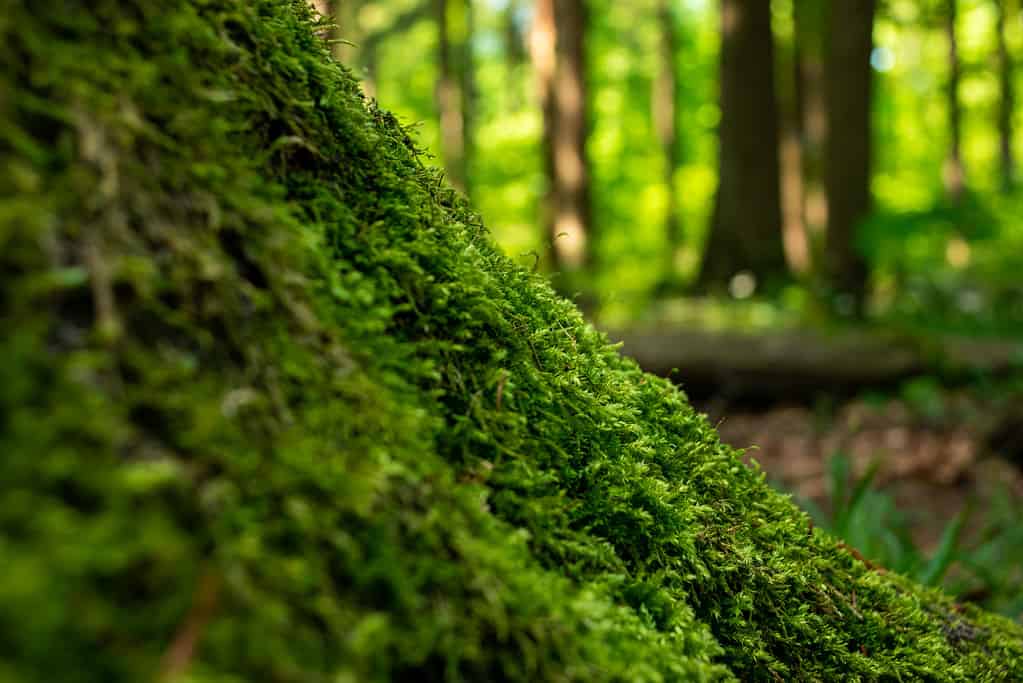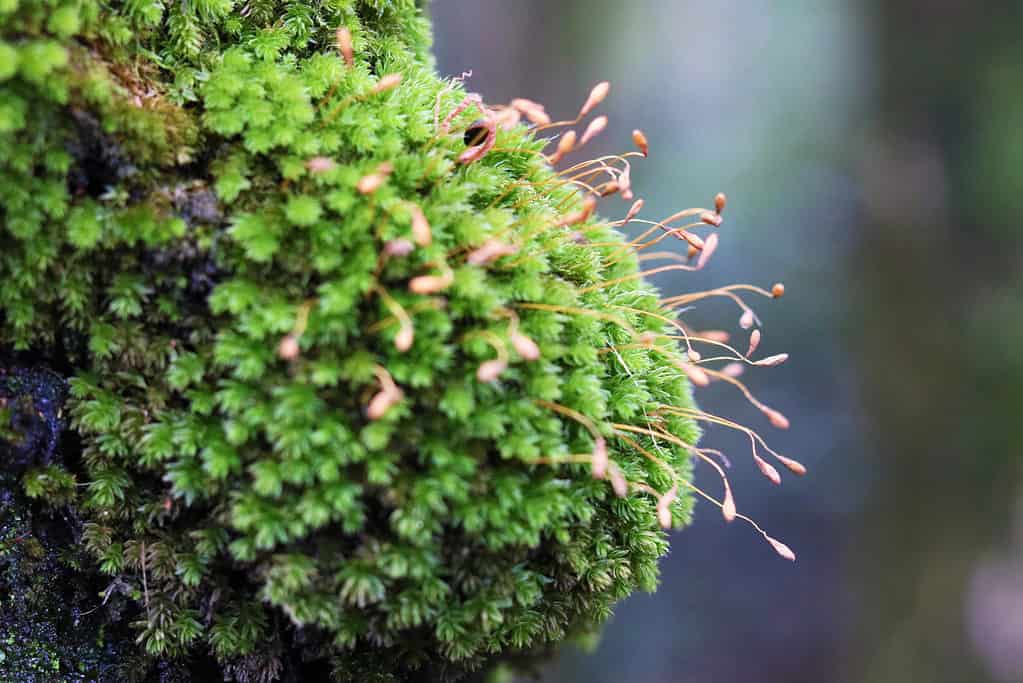Mosses and algae show up across a surprisingly vast portion of our world and, in some instances, they are easy to mistake for one another. In this article, we’ll highlight the similarities and differences between mosses and algae and take a look into the lives of these important photosynthetic organisms.
1. Classification and Lineage

Algae and mosses evolved at very different periods in the Earth’s history, but share a single, ancient ancestor who harnessed early photosynthetic organisms.
©Pierrette Guertin/Shutterstock.com
While algae and mosses share some similarities, they belong to very different kingdoms. Algae belong to kingdoms Protista or Chromista while mosses rest firmly within the plant kingdom, Plantae. Photosynthetic bacteria evolved much earlier than plants and algae and, essentially by conscription, endowed these organisms with the ability to photosynthesize. Long ago, early protists engulfed these bacteria, beginning what would turn out to be a long-standing, mutually beneficial partnership. Over billions of years, this ancient, endosymbiotic relationship eventually gave rise to the algae and the plants, both terrestrial and aquatic. The algae appeared on the scene first, around 3 billion years ago, with the advent of land plants occurring much later, around 500 million years ago.
2. Habitat

The majority of the world’s algae species are very tiny, living alone or in colonies in aquatic environments.
©Jason Finn/iStock via Getty Images
One of the main differences between mosses and algae is where they tend to grow. Overwhelmingly, algae live in aquatic environments. Most of the world’s algae species are phytoplankton, which inhabit the shallower zones of the ocean where light is plentiful. They are the most important producers in the world, providing a source of food to countless larger organisms. They also generate about half of all of the oxygen on Earth.
More than just the oceans, however, algae also inhabit a wide range of freshwater environments. They are a common sight on rock and root surfaces in creeks, streams, lakes, and rivers. Oftentimes, they resemble a film or slime. Many freshwater species free-float through a body of water just like their microscopic marine counterparts. Whether anchored or free-living, unicellular algae can grow singly or in colonies. Algae are incredibly versatile and can grow in extreme environments, including those that are highly acidic or alkaline, very bright or dim, or even those that experience extreme temperatures.
Mosses, on the other hand, are overwhelmingly terrestrial. They cling tight to various surfaces like rocks, trees, decaying plant matter, or simply the ground. Mosses can also inhabit a wide variety of environments, from mild to extreme, and appear on every continent on the planet, including Antarctica. Some species, like Vesicularia dubyana, can grow and reproduce even when completely submerged in water.
3. Structure

Terrestrial algae and the overwhelming majority of mosses lack the vascular structures necessary to support larger bodies and must therefore remain low to the ground.
©Octavian Lazar/iStock via Getty Images
Probably the most important difference between mosses and algae is their structure. They are similar in that they both generally lack vascular tissue and therefore take up water solely by osmosis. However, mosses have true stems and leaves whereas algae do not. Both mosses and algae also lack roots but differ in how they anchor themselves to their environments.
Algae can vary quite a bit in terms of form and function. They can be simple and very small or exceedingly large. Alone, tiny microalgae are often too small to be observed by the naked eye. When they form large colonies, however, they often resemble slime, hair, or floating masses. Some macroalgae, like seagrapes (Caulerpa lentillifera), are single-celled but have many structures that are analogous to those of land plants. Much larger macroalgae, like giant kelp (Macrocystis pyrifera) may resemble plants but do not have true leaves or stems. Instead of roots, these organisms use holdfasts to anchor them in place. Mosses make use of similar but distinct structures, called rhizoids, to secure their footing. These resemble roots but do not absorb water or nutrients from the environment.
While all algae contain chlorophyll and carry out photosynthesis, not all algae are green. Some, like Rhodophyta algae, contain red pigments that mask their green chlorophyll and allow them to photosynthesize deeper in the water column. Others, like single-celled golden algae (Prymnesium parvum), appear yellow-green or gold during a large bloom. Like algae, many true plants, including mosses, can deviate from having green coloration. The red parasol moss (Splachnum rubrum), for example, can vary from light red to dark red, and can even approach black coloration.
4. Size

Aquatic macroalgae spend their lives suspended in all they need to live and therefore don’t experience the same size limitations as terrestrial mosses and algae.
©iStock.com/Shur_ca
Because both mosses and algae rely entirely on osmosis to acquire water, their size on land is very limited. Without the vascular structure necessary to transport water to great heights or across long distances, both must remain very low to the ground. While mosses may form very large colonies, carpeting entire fields, trees, bluffs, or boulders, most can never grow more than a couple of inches in height. The tallest species of moss on the planet, Dawsonia superba, tops out at just 24 inches. Mosses in this genus, however, are unique from the rest, possessing a special type of water transport system that evolved separately from that of the vascular plants. Without it, they could never attain such height.
Terrestrial algae run into similar problems to those of the mosses and need to remain very small. These are often microscopic and form thin films or dustings over the surfaces on which they grow. In the water, however, acquiring moisture and nutrients is much easier, allowing for a very wide range in size. Neither aquatic microalgae nor macroalgae have to work to obtain moisture or nutrients. They are simply suspended in all that they need to grow. As long as they have access to sunlight, they can manufacture the food they need from the environment in which they are suspended. Being suspended in water also means that aquatic macroalgae do not need to create rigid structures to support their bodies. Without the same restrictions as land plants, they can grow as large as they need to, relying only on buoyancy to keep them oriented toward the sun.
5. Reproduction

During their reproductive phase, gametophyte mosses give rise to sporophytes on long stalks.
©Gaian child/Shutterstock.com
Both types of organisms can reproduce both sexually and asexually, by division or simply breaking apart. The smaller microalgae generally reproduce asexually, via division. In this process, called mitosis, a single-celled algae splits its chromosome in half and divides itself in two. The chromosome pairs then reassemble in the new cells, resulting in a pair of daughter cells that are genetically identical. Some microalgae, however, reproduce sexually by a process called meiosis, in which they divide their nuclei several times to create gametes. These gametes contain small divisions of the parent cell which, when combined during reproduction, produce offspring that are similar but genetically distinct from the parent cell.
Larger macroalgae take sexual reproduction a step further, producing special reproductive structures and going through a process called the alternation of generations. These algae produce gametes in patches called sori and then release them into the environment. When these gametes, called spores, germinate, they grow asexually as gametophytes until they meet a genetically compatible partner. They then combine to form a zygote that grows into a genetically complete sporophyte. Now capable of producing spores, the sporophyte grows to maturity and reproduces, beginning the life cycle again.
Like the macroalgae, mosses undergo an alternation of generations. Mosses spend much of their time in the gametophyte phase, which people tend to be the most familiar with. This is the leafy, carpet- or clump-forming stage that spreads over various surfaces. Eventually, these gametophytes produce one of two reproductive structures — antheridia, which are male, or archegonia, which are female. Antheridia release sperm which must then swim across the ground and into a neighboring archegonium to form a zygote. This zygote develops into a stalk-like structure that produces new spores, which are dispersed to begin a new generation.
Breakdown of the Differences Between Mosses and Algae
| Mosses | Algae | |
| Classification | Kingdom Plantae | Kingdoms Protista, Chromista |
| Habitat | Generally terrestrial but may be aquatic as well. Can grow in extreme environments. | Generally aquatic but sometimes terrestrial. Can grow in extreme environments. |
| Structure | Multicellular, generally non-vascular, photosynthetic. Have very simple leaves and stems and rhizoids to attach them to surfaces. No roots — the entire plant is absorptive. | Unicellular or multicellular, non-vascular, photosynthetic. No leaves, stems, or roots — the entire alga is absorptive. |
| Size | Multicellular, generally non-vascular, photosynthetic. They have very simple leaves and stems and rhizoids to attach them to surfaces. No roots — the entire plant is absorptive. | Widely variable, from microscopic to very large. Some, like giant kelp, can grow more than 2 feet per day. |
| Reproduction | Sexual via spores or asexual via fragmentation or division. | Sexual or asexual via fragmentation or division. |
The photo featured at the top of this post is © sstevens3/Shutterstock.com
Thank you for reading! Have some feedback for us? Contact the AZ Animals editorial team.







